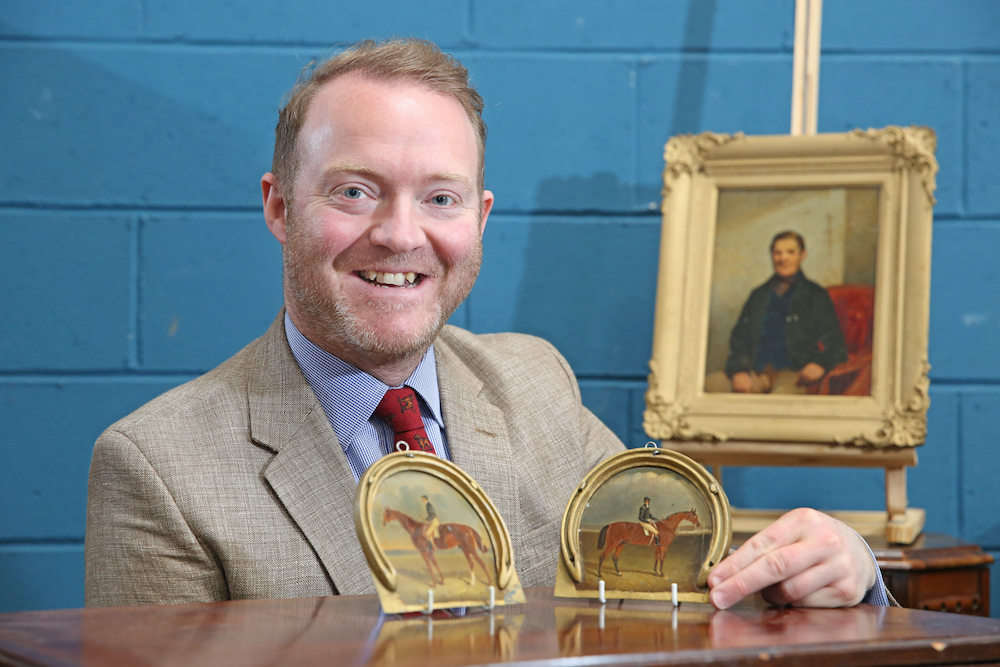Derby winners portraits could romp home
 Two miniature paintings of Derby winners belonging to John Bowes (1811-1885) – founder of the world-famous Bowes Museum and one of the greatest racehorse owners of all times – are due to be auctioned next month after lying unnoticed for 180 years.
Two miniature paintings of Derby winners belonging to John Bowes (1811-1885) – founder of the world-famous Bowes Museum and one of the greatest racehorse owners of all times – are due to be auctioned next month after lying unnoticed for 180 years.

The oil on metal paintings make up a set of four identically presented paintings depicting all of John Bowes’ Derby winners. The other two are held by and are on view at the Bowes Museum in Barnard Castle, and until recently art experts knew nothing about the whereabouts of the missing pair.
The two paintings depicting ‘Mundig’ (1935 Derby Winner) and ‘Cotherstone’ (1843 Derby Winner) are being offered for sale by the North Yorkshire auction house Elstob & Elstob as part of their Pictures and Sculpture Sale on 30 November, together with a portrait of Issac Walker, who was Head Groomsman at the Streatlam Stud owned by John Bowes.

“It is remarkable that these paintings have finally come to light,” said auction house director David Elstob. “They have come forward from a client in Matlock, Derbyshire, who has had them in the family for as long as can be remembered. The family originated from Weardale in County Durham – close to the Bowes Museum – and the client remembers them hanging in his grandparents’ cottage in the village of Howden le Wear. His grandfather was friendly with Issac Walker’s family, which may explain how the paintings came to be in their hands.”
Each painting measures only 12.5cm x 13cm and are both presented in horse shoe frames; these are known as racing plates and would almost certainly have come from the Derby winners themselves. The two paintings, together with the oil on board portrait of Issac Walker, carry a price estimate of £1,000 – £1,500. It is not known who painted them but they are attributed to the circle of Henry Thomas Alken (1785-1851).
The paintings are particularly significant to the equestrian world due to John Bowes’ great fame as one of the most successful racehorse owners this country has ever known. During his career he had four Derby winners, a feat matched by only five other breeders in the history of the race and only exceeded by HH Aga Khan III with five, a truly remarkable achievement. John Bowes earned a great fortune from his racing activities, which played a major part in funding the Bowes Museum; built in an elaborate French Chateaux style to house the art collection of John and Josephine Bowes and opened to the public after their deaths in 1892.
Mundig was the first of Bowes’ hugely successful horses. He was foaled in 1832, the year that John Bowes turned 21 and indeed Mundig is German for mature or ‘of age’. He was in the first batch of horses that Bowes sent to trainer John Scott known as ‘the wizard of the north’, who had the Whitewall training stables at Malton, near York. When Mundig won the 1835 Derby, he became the first northern-bred horse ever to do so, despite relatively poor odds.
Cotherstone was another outstanding champion, again trained by John Scott and ridden by his brother William Scott to achieve victory in the 1843 Derby, winning by two lengths. In that same year, he won the Two Thousand Guineas, and came second in the St Leger, making John Bowes a total in excess of £12,000 (£1.2 million in today’s values), and securing his position as one of the most valuable horses in the country. Eventually, Cotherstone was sold for breeding purposes to Lord Spencer in 1844 for 3,000 guineas (£300,000 today).
Issac Walker was Head Groomsman at the Streatlam Stud from 1833-1872. He took over this role from his father and between them they served in the position for over 70 years. Issac died tragically from drowning.
“These paintings represent a snapshot of one of the most remarkable success stories in racing history and, together with the links to the renowned collection of art in the Bowes Museum, we are expecting them to attract worldwide interest from equestrian enthusiasts and art collectors alike,” said David Elstob.

